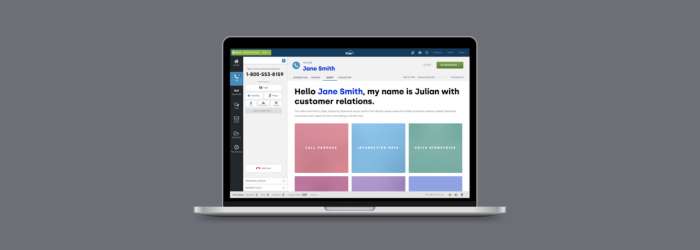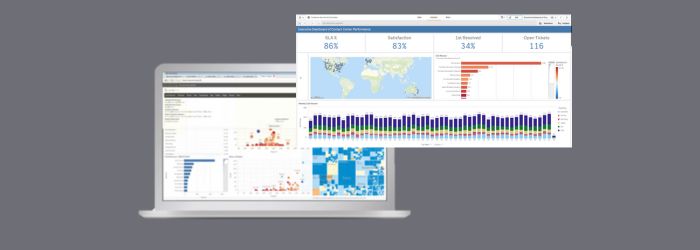Contact Centers don’t seem flashy, but they can be the lifeblood of an organization. Having a good customer experience via your contact center is critical to continued success.
The Challenge of Modern Expectations
Contact Centers (essentially the updated version of call centers) don’t seem flashy, but they can be the lifeblood of an organization. Microsoft’s 2020 Global State of Customer Service found that 90% of American consumers use customer service as a factor in deciding whether or not to do business with a company and 58% will switch companies because of poor customer service. (1) Having a good customer experience via your contact center is critical to any organization’s continued success.
Supporting the customer experience expectations of today’s consumers requires an “always-on” approach that reaches much further than a traditional call center. More than 40% of today’s consumers consider having support available 24/7 to be a hallmark of good customer service, according to the Zendesk Customer Experience Trends Report 2020. (2) To meet these expectations, the most successful organizations take advantage of cloud-based, omnichannel customer support via contact centers as a service (CCaaS).
While meeting consumer expectations has become harder in recent decades, the advent of omnichannel, cloud-based contact centers has also led to business benefits. This approach often results in deeper data insights, optimized budgets, increased flexibility, and a competitive advantage.
Why “Call Centers” Are Dated
While the switch from “call center” to “contact center” may seem unnecessarily nuanced, it’s an important distinction. Think about all the different ways you as a consumer interact with a company. Yes, you may call, but you might also:
- Send an email
- File a support ticket via a web form
- Search a company’s FAQs or knowledgebase
- Interact with a live or automated chat on the website
- Use SMS text support
- Reach out via social media
 Calling is no longer the only way consumers engage with companies, and a growing number of consumers consider it a “bad experience” when support isn’t available via their desired contact method. Organizations need to be prepared to support each communication channel equally. Top performing companies have learned how to turn multi-channel support into a data goldmine via omnichannel CCaaS solutions.
Calling is no longer the only way consumers engage with companies, and a growing number of consumers consider it a “bad experience” when support isn’t available via their desired contact method. Organizations need to be prepared to support each communication channel equally. Top performing companies have learned how to turn multi-channel support into a data goldmine via omnichannel CCaaS solutions.
Benefits of Omnichannel CCaaS
Omnichannel contact centers create a centralized customer support experience that allows consumers to engage with an organization through a variety of channels. This is quickly becoming table stakes for organizations. Microsoft’s 2019 State of Global Customer Service Report (3) found that 50% of consumers use an average of three to five communication channels when engaging with a company. Sixty-six percent try to self-solve their issues before reaching out to customer support. If you don’t have these options, consumers will become frustrated with your company as a whole.
Supporting multiple avenues of communication is also important as generations age into buying aged consumers. Research shows that customer preferences for contact methods are very generational. Phone support remains popular across all demographics, but 40% of Millennials/ Gen Z enjoy using messaging platforms compared to just 20% of Baby Boomers, according to the 2020 Zendesk report. These communication method preferences are likely to continue shifting as younger generations get older and as new forms of communication become the daily norm. Successful companies will embrace contact center solutions that can easily adapt to these changes.
Omnichannel contact centers also provide inward-facing business benefits. Centralizing consumer engagement data allows for deeper insights that can add value to the organization. Many CCaaS solutions have in-depth reporting that can help organizations optimize staffing, identify trends, and improve agent training. High-end management oversight features also allow managers to review past engagements or even jump in on live interactions to better facilitate the process.
Having information about a phone call, web portal support ticket, and a social media chat engagement in the same location (regardless of which internal team handled the interaction) gives companies a better picture of the entire customer journey. It’s also what today’s consumers expect. More than 40% of consumers rate having to repeat their information as a top pain point of a bad customer experience, according to the Zendesk Trends report. Nearly 30% consider it a bad experience when the agent they’re currently engaging with doesn’t have sufficient information on file, the same report found. This is inevitable if your call center team and your web support team do not have insight into how the consumer has previously interacted with other communication channels, what information they’ve already shared, details on the issue at hand, and what’s been done to address it already.
The data centralization benefits created by an omnichannel approach to contact centers helps organizations and their customers by:
- Creating a better user experience
- Giving organizations access to comprehensive, insightful, real-world data
- Eliminating customer support data silos
- Increasing customer retention
Cloud-Based CCaaS Cost Savings
Building out this comprehensive approach to customer support may seem expensive and daunting, but cloud-based CCaaS solutions make it affordable for organizations of all sizes. Running a contact center likely isn’t your area of expertise, so why spend time, energy, and budget on building a solution in-house when you can access a high performance, ready-togo solution? When working with a CCaaS provider, you no longer have to worry about:
- Maintaining data center infrastructure, including upgrades and refreshes over time
- Purchasing extra servers or floor space to support growth
- Hiring enough full-time employees to support the contact center 24/7
- Managing scaling needs (infrastructure and staffing)
CCaaS is adaptable, affordable, and highly scalable, allowing you to easily flex based on seasonal or realtime needs. The data-driven approach of cloud-based CCaaS also provides insights you may have been unaware of, allowing you to identify previously hidden trends that allow for smarter staffing.
Additionally, if providing a better customer support experience helps retain customers, you can see additional cost savings. Attracting new customers costs five times more than retaining existing ones, according to Invesp. (4) It’s important to take less obvious cost savings like this into account when considering CCaaS, as the shift may have overall cost benefits that go beyond obvious numbers on an order form.
Getting Ahead of the Competition
Since consumers are willing to leave organizations that provide subpar customer service experiences, organizations with strong customer support stand to gain these disgruntled consumers. Right now, there is a lot of opportunity in this space for organizations that adopt omnichannel CCaaS solutions. Currently, less than 30% of companies offer in-demand customer support channels such as self-service centers, live chat, or social messaging/in-app messaging, according to Zendesk.
Other than potentially gaining customers, organizations that embrace CCaaS see clear productivity gains. The ability for consumers to access self-service troubleshooting information reduces the overall number of support requests. Centralized data and the deep levels of management insights and reporting associated with cloud-based contact center solutions allow agents to resolve issues faster and support more customers with fewer on-duty agents.
“Companies that leverage the most customer data — those in the top 25% of managing data relative to other similar companies — see 36% faster resolutions and a 79% reduction in wait times. They also solve four times the number of customer requests. These gains in productivity are hard to argue with, especially considering that High Performers are more [than 2x as] likely to take an omnichannel approach, offering customer interaction through more channels, utilizing more features, leaning on more data and analytics, and empowering their teams with both more training and autonomy, especially when it comes to knowledge management.”
The shift to smart cloud-based contact center solutions is coming. Calabrio’s “State of the Contact Center 2021” (5) report found that three in four contact centers moved to the cloud in the past year. In 2020, one in 10 contact centers were fully cloud-based. That number is now up to four in 10. Organizations that don’t embrace CCaaS risk being left behind with outdated customer support features.
CCaaS Best Practices
 Understanding what you need from a CCaaS provider is an important first step. Many organizations look for features such as:
Understanding what you need from a CCaaS provider is an important first step. Many organizations look for features such as:
- An easily scalable solution
- Support for multiple communication channels (with room for growth as new channels may emerge in the future)
- Management controls
- Agent training
- In-depth reporting and analytics
To get the full benefit of cloud-based CCaaS, ensure you have a good understanding of all the solution features available and are using them to their full capabilities. Invest in good training and look for ongoing training opportunities. Analyze insights to identify topics you can add to a self-help section or usage trends that can lead to smarter staffing. Organizations won’t get the full benefits of CCaaS if they simply replace one call center solution for another. You need to be invested in this enhanced solution and find the right CCaaS provider for your individual needs.
By delivering deeper data insights, cost savings, and increased flexibility, cloud-based contact center solutions provide businesses with a competitive advantage in their marketplace. CCaaS is adaptable, scalable, and affordable, and can help your company attain and retain customers.
Sound interesting? Let’s talk. Contact us today to get started!
(1) Microsoft, “Global State of Customer Service: The Transformation of Customer Service from 2015 to Present Day,” 2020. https://info.microsoft.com/ww-landing-global-state-of-customer-service.html
(2) Zendesk, “Zendesk Customer Experience Trends Report 2020,” 2020. https://www.zendesk.com/blog/zendesk-customer-experience-trends-report2020/
(3) Microsoft, “State of Global Customer Service Report,” 2019. https://info.microsoft.com/rs/157-GQE-382/images/EN-US-CNTNT-ebook2018State-of-Global-Customer-Service.pdf
(4) Invesp, “Customer Acquisition Vs.Retention Costs – Statistics And Trends.” https://www.invespcro.com/blog/customer-acquisition-retention/
(5) Calabrio, “State of the Contact Center 2021,” 2021. https://info.calabrio.com/state-of-the-contact-center-cloud-is-here/
.png?width=700&height=127&name=Blue%20Mantis%20formerly%20known%20as%20SME%20Solutions%20Group%2c%20Inc.%20(GREEN).png)


